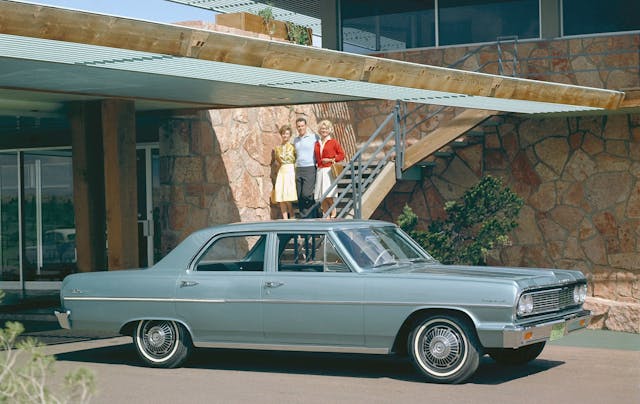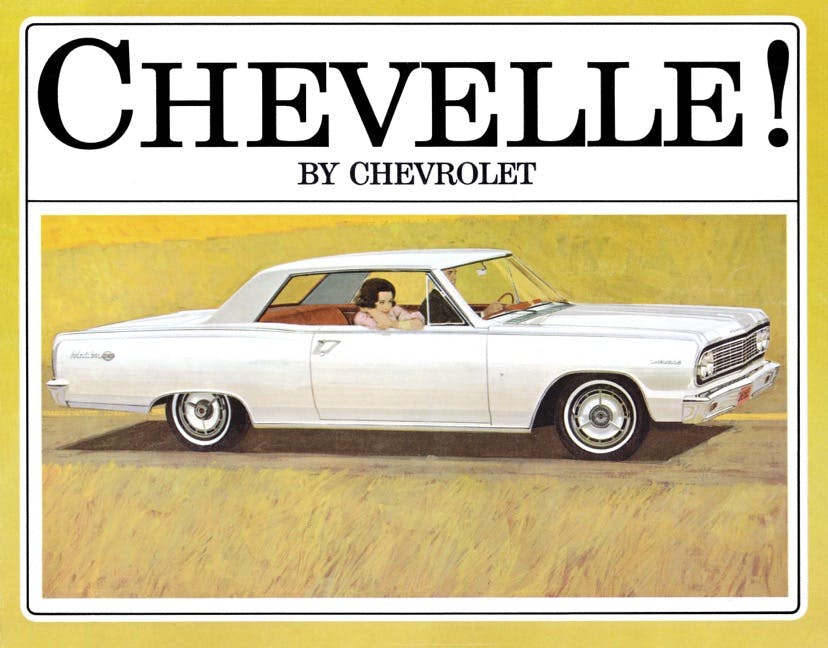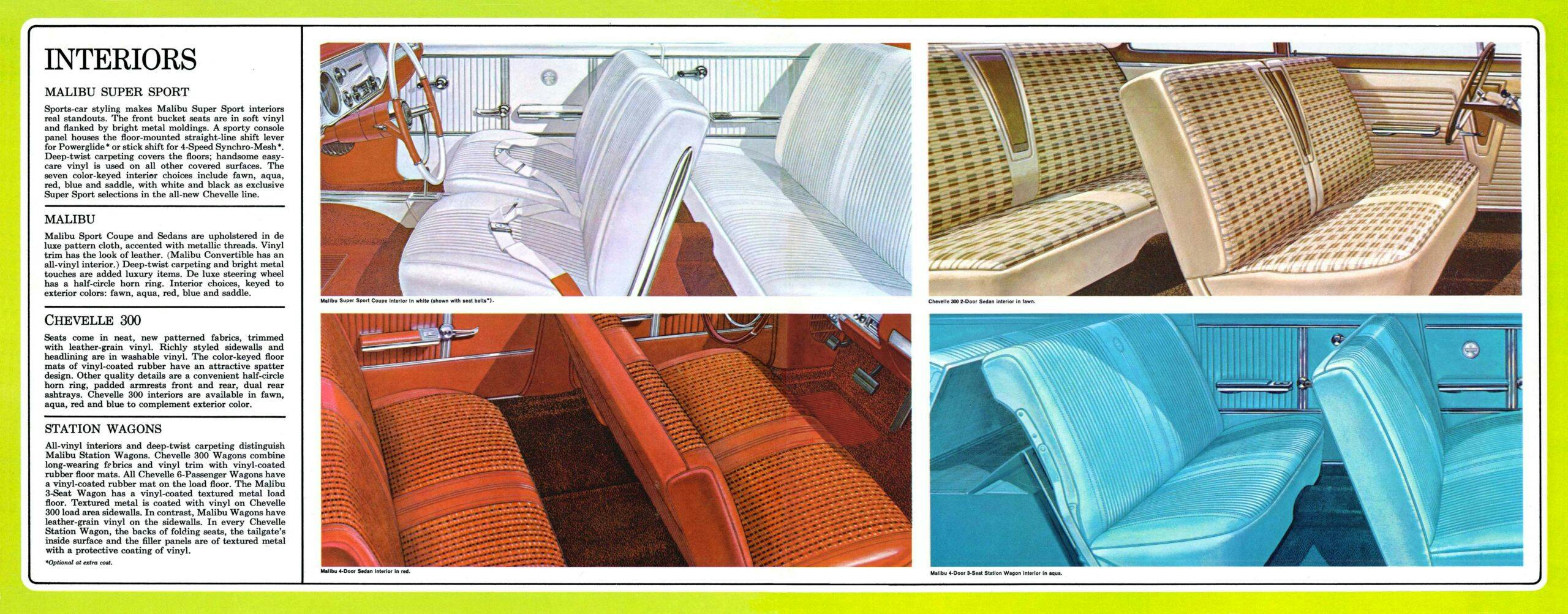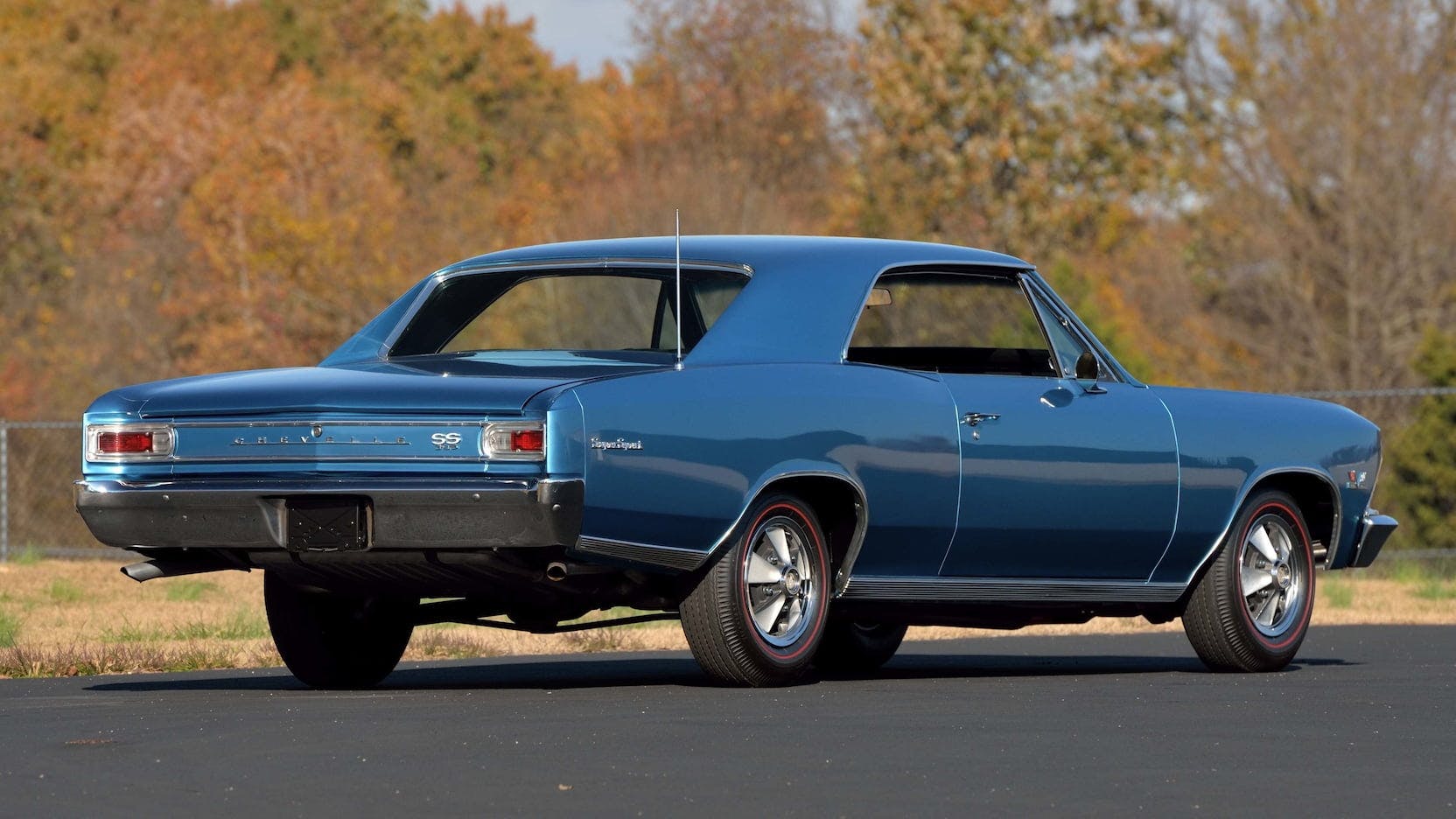Your handy 1964–67 Chevrolet Chevelle buyer’s guide
The automotive market went through a series of sweeping changes in the early 1960s. Not the least of these was the rise of small-to-intermediate-size cars, vehicles that were cheap to build, affordable to buy, and popular with drivers who needed basic transportation at a reasonable price.
Chevrolet’s answer to the entry-level question was the 1964–67 Chevelle, a car that built on the lessons learned from the smaller Chevy II and ahead-of-its-time Corvair. Larger than both, but more modestly proportioned than full-size fare like the Impala, the intermediate Chevelle was an immediate homerun for the brand, with 1.6 million first-generation cars sold. (Click here to read about our recent drive of a ’67 Chevelle.)
Helping to propel Chevelle sales was its extreme versatility. Here was a car that could be ordered as a coupe, sedan, convertible, and a pair of wagons (two-door and four-door), outfitted with equipment ranging from barebones to respectably comfortable. Riding on GM’s all-new A-body platform, the Chevelle also birthed the reborn El Camino pickup, which added a cargo bed (and which is outside the scope of this buying guide), as well as the Malibu, which served time as a Chevelle trim level before graduating to its own nameplate. Most body styles featured the choice between frugal six-cylinder power or an upgrade to either small-block or big-block V-8, with the latter powering the iconic Malibu Super Sport and the SS396.
A big part of the Chevelle’s continuing popularity among collectors also has to do with how easy it is to modify. Capable of receiving nearly any small-block design in its capacious engine bay, and bolstered by an incredibly deep aftermarket, there are nearly as many customized Chevelles out there as there are numbers-matching originals, a fact underscored by just how cheap it can be to buy a rolling shell or even complete base car to use as a template for building an SS clone.
Charting the changes

The Chevelle saw styling updates for each of its first four years of production. The 1964 models are easily identifiable by way of their upright, egg-crate grilles, a feature that was replaced by a chrome bar that bisected the front end of the car for 1965. Both the ’64 and ’65 feature a rounded grille surround that encapsulates the headlights, with the ’65 adding a kink at the far edge. Changes are equally prominent at the rear, with the original split taillamps being replaced by one-piece units and the trunk filler swapping from chrome to black and adding C-H-E-V-R-O-L-E-T lettering across the center instead of across the top of the trunk lid.
The 1966 Chevelles have a canted front end, with the the front of the hood angled above the bumper and the bottom of the grille recessed into the fenders. Headlights are no longer flush but instead stick out, and the grille loses its center trim in favor of small horizontal bars. These bars become more prominent for 1967, which also loses the ’66 bumper cutouts in favor of one large cutout that slices across the entire unit and houses the turn signals. The hood is also smoothed back for ’67, and the fenders pushed forward to erase the previous year’s diagonal slice.
Angles are also the order of the day at the rear of the Chevelle. The 1966 edition features protruding fender edges that house curved rectangular taillights, while 1967 frenches those lights into the fender edges themselves and transforms them into triangles. A full-across trim piece is also present for ’67 in place of the ’66 model’s body-color backstop with chrome surround and Chevrolet logo center trim. Wagons feature different tailgate and taillight setups for each of the four first-generation model years.

Chevelle trim levels (called “series” by GM) were fairly restrained. For 1964, buyers could choose between the base 300, the mid-tier Malibu, and the muscular Malibu SS. The latter two featured their own unique badging but otherwise matched lesser models in terms of styling. The following year the 300 Deluxe was added to the mix, and by 1966 the SS396 had replaced the Malibu SS. The final change of note is the Concours trim for 1967, which was wagon-only. Malibu SS and SS396 cars were sold exclusively as coupes or convertibles.
Equipment ran the gamut from stripped-down Taxi fleet cars all the way up to plush Malibus with full power accessories, power steering, air conditioning, and bucket seats. Optional gear included a Positraction limited-slip rear differential, a four-speed manual transmission (which replaced the column-shifted three-speed with a floor-shifter), and a two-speed PowerGlide automatic.

Engine choices for the 1964 Chevelle consisted of a pair of straight-six engines (a 194-cubic-inch unit good for 120 horsepower, and a 155 horsepower, 230-cu-in design), as well as two versions of the 283-cubic-inch small block V-8 (195-hp, two-barrel carburetor, and 230-hp four-barrel), and a pair of 327-cubic-inch V-8s (250-hp two-barrel, 300-hp four-barrel).
It’s important to point out that the Malibu SS was available with both V-8 and I-6 engines, and that ordering the model did not guarantee a high-performance engine under the hood. Similarly, in all years SS cars came standard with the three-speed manual, with the four-speed optional, as it was on nearly every other Chevelle.
Horsepower fluctuated somewhat for the I-6 and 283 for 1965, with the 327 gaining a third, 350-pony version, but the big news was the new 396-cu-in big-block L37 V-8 that added 375 horsepower and 420 lb-ft of torque in a very limited number (only 200) of Malibu SS models (also known as Z16 cars). This hydraulic cam motor was unique to 1965, and differed from the L78 396 offered by the Corvette that same year, and the Chevelle SS396 the following year.

A 396 big-block became standard in the newly created SS396 trim for 1966, available in 325-hp (L35), 360-hp (L34), and 375-hp (L78) editions, while the 327 returned to a single, 275-hp option on non-SS cars. For 1967, buyers were given an extra 325-hp, 327-cu-in V-8 to choose from, while the L34 big-block lost 10 hp and 5 lb-ft of torque. Only 612 L78-equipped SS396 cars were built that final year, due in part to the engine not being available until late April/early May 1967.
Who to know before inspection
If you’re looking for comprehensive online information about the Chevrolet Chevelle, it doesn’t get much better than Chevelle Stuff, which offers decoders for VINs, warranty cars, and trim tags; full lists of all options, features, and trim levels; and deep dives into every model year. It also features registries for a vast array of specific Chevelle models.
As with many muscle cars, those who have built companies dedicated to keeping these vehicles on the road are also excellent resources when it comes to digging into their history. We spoke to Roger Ausley of Ausley’s Chevelle Parts to get a better understanding of how to identify a ’64–67 Chevelle when looking at its VIN plate (located on the front hinge post of the driver’s door) and trim tag or body plate number (driver’s side firewall).

In 1964, the VIN was 11 digits and 1 letter, and for ’65–67 it shifted to 12 digits and 1 letter. In ’64, the first digit of the VIN is 4 to represent the model year. Canadian-built cars kept this going for 1965 and ’66, but American models shifted to a 1 as the first number from ’65 onwards, which indicates that the vehicle is a Chevrolet. The second number pair represents the series and engine type of the vehicle, with the next two digits indicating body style. In 1964, the letter that follows denotes the assembly plant (there were five in the United States), but for ’65–67 cars a number is inserted before the assembly-plant letter to show the production year. This is followed by the serial number, which always begins with a 1.
“The thing to keep in mind about serial numbers is that GM couldn’t do them sequentially,” Ausley explains. “Each number is specific to the plant where it was built, and that particular vehicle’s position on the assembly line.” This means that a Super Sport with serial number 00004 doesn’t mean it’s the fourth SS ever built, it just means it’s the fourth Chevelle—and even then, it’s the fourth Chevelle built at that specific plant.
There are also some details that only an expert would know that will help when inspecting a potential purchase.
“Prior to 1965, the VIN numbers were attached with two spot welds onto the door frame post, or they had rivets,” he continues. “In ’65, a federal law was passed that all VIN plates had to be attached with a rosette rivet. However, some 1965 model year cars were built in late 1964, so only ’65 model year Chevelles constructed after January of that year have this type of tag. This can lead to DOT claims that a VIN tag was removed and reinstalled, but it simply isn’t true, so you have to check the actual build date of the vehicle to authenticate the plate.”
Given that the Chevelle Malibu SS and SS396 are very easy to clone, it also helps to be prudent when inspecting the details that set these more desirable models apart.

“We have a series of videos on YouTube showing where the emblems on these cars are supposed to be,” says Ausley. “Badges in the wrong spot is one of the most common discrepancies you’ll encounter when looking at a clone car. We also have a tech-tips series that goes further into year-to-year changes between the cars.”
Sometimes the clues indicating you’re looking at a real Super Sport are so hidden as to be practically invisible.

“All SS models had a set of small brackets mounted to the rear lower control arms that weren’t on the regular Malibus, or any other Chevelles,” explains Ausley. “These were for 12-inch support bars that you won’t find anywhere else.” He also says that there were no SS El Caminos (just cars featuring optional big-blocks), and that while no Chevelle came with a 427-cubic-inch V-8 from the factory, some dealers did install them after delivery to skirt GM rules about big-block engines in intermediate platforms in that era.
Ultimately, according to Ausley, the best way to authenticate a potential purchase is to ask for as much documentation from the seller as possible. This includes the original bill of sale, a build sheet, and any paperwork available from the original owners, all of which are considered the gold standard when paying for a high-dollar car.
Before you buy

Mechanically, the 1964–67 Chevelle is rock-solid. With a choice between basic small-block Chevy engines, stout straight-sixes, and well-understood big-blocks, the only issues you’ll encounter in the engine bay are related to age and mileage and can be addressed as they would in any other vehicle. Suspensions, rear ends, and transmissions are similarly uncomplicated, and parts availability is excellent across the board (including a strong market for reproduction pieces and sheetmetal).
“Keep an eye on the floorboard on the passenger side, as that’s where leaking heater cores tended to trigger rust,” Ausley says. Other areas with rust related to poor drainage include the rear corners of the back window, behind the rear wheels, and the bottoms of the front fenders. He also points to the door bottoms (where drains were blocked by pieces of the fuzzy window sweeps falling into the door) and later cars that used butyl tape instead of a gasket to seal the windshield as further areas of concern.
“Keep in mind, GM was not interested in a car that lasted 30 years,” he explained. “They wanted to build a car that lasted three years, so you’d have to buy a new one.”
What to pay

For up-to-date values of the exact Chevelle you’re shopping, consult the Hagerty Valuation Tool. For a breakdown of Hagerty’s 1-to-4 vehicle-condition rating system, click here.
The original Chevrolet Chevelle remains a popular choice with collectors. With prices for sparsely equipped six-cylinder sedans hovering just above the $10,000 mark for Excellent, or #2 condition, examples, the Chevelle provides an easy entry point into the hobby, especially when looking at even more affordable #3 (Good) condition driver-quality examples.
That being said, coupes and convertibles featuring V-8 power can easily double or triple that price in #1 (Concours) or even #2 condition, to say nothing of the Super Sport, which can range from $50,000 to over $100,000 (not including outliers like the ultra-rare Z16 V-8 SS models that jump to nearly $200K). Values have risen nearly 20 percent across the board for the Chevelle over the past three years, based on Hagerty quotes, with strong interest from both baby boomers and Gen X representing the majority of those making inquiries.
As with any classic, it’s in your best interest to purchase the best-condition vehicle you can afford rather than target a cheaper, project-level Chevelle. Although you won’t have any trouble locating new or used parts, outside of investment-grade blue-chip models, the labor and investment required to restore an old automobile almost always eclipses its actual value.
***
Check out the Hagerty Media homepage so you don’t miss a single story, or better yet, bookmark it. To get our best stories delivered right to your inbox, subscribe to our newsletters.
















Great article!
I was working afternoons at the local Chevrolet dealership mainly I worked on trucks but this one afternoon I will send it over to do some warranty work on a 64 Chevelle 2dr ht I was very surprised when I open the hood and found a 325 horse 396. when I finished the electoral repair I went back to working on a toro flow.
I would take a 66 or 67 in a heartbeat but kind of prefer the 67 looks.
I don’t recall any 2 bbl 327. The early 327 had a Rochester 4 bbl with 250 hp. The 300 hp 327 had a Carter 4 BBL and higher compression heads.
I had a 65 Impala 2-dr hardtop, 327/300 4-speed, and experienced rust under the rear-window corner, the same as described for Chevelles. But I did love that car!
If you can find an original 327 base V8 powered 67 Camaro you will find a 210 hp 2 barrel engine. I believe it was also available in 68. The Camaro also got engines before even the Corvette. The stock V8 in 67&68 SS’s was a 350. The Corvette didn’t get it until 69.
My dad picked up a ’65 SS in 1967 when he got home from Vietnam. 283 and 3-spd car with a white vinyl top. At some point dad had the top redone to black. I own it now and have always wondered if the vinyl top was a factory option, dealer add-on, or if someone just covered up a hardtop years ago because they thought it would look good. The VIN does not dive deep enough for me to figure it out…
To me Chevelles are like Mustangs, just too many produced to be interesting. Of course everyone is entitled to their opinion (and wallet) and undoubtedly that very ubiquity creates nostalgia for some people.
A sidebar to the 1964 230 ci engine is that it was rated at 155 HP in the Chevelle and Chevy II, while it was 140 HP in the full size Chevrolet. The ‘high performance’ six was topped with a chrome valve cover, air cleaner lid, oil filler cap, vacuum advance line, and dipstick. My 1964 parts book shows it used a different cam, distributor, and carb than the regular 230. It returned as an option in 65, but now rated at 140 HP, same as the other 230’s used that year, but still sporting the chrome goodies.
We had one in a 1964 300 four door sedan my father bought new in October of 63.
Not mentioned here was that in typical GM fashion, Chevy was late to the intermediate platform. The Chevelle was introduced in 1964 to compete with the less-than-full-size unibody offerings of the Ford Fairlane/Mercury Meteor and Plymouth Belvedere/Dodge Polara, which were introduced in 1962.
It could be argued the ‘intermediate’ sized car began with the ’58 Rambler Classic. It helped AMC move into an incredible 3rd place behind Chevy & Ford in 1960 new car sales. That success surely was not overlooked in Dearborn…
I have four now. One a ’64 more door that is my daily transport in the Summer. It was originally a 194 six, but now has a 41,000 mile original 283 from a ’67 El Camino and a 2004R overdrive. The ’67 El Camino is in the shop getting a full on make over. I also have a ’64 El Camino, now with EFI and a 5-speed and soon to be in the group a’66 Chevelle two door post. Love them all!
My first car was a ’66 Chevelle with the big 6 and power glide. Some rust issues not mentioned include water being caught by the bumper lip and running down the trailing frame rails. Mine were almost completely rotted away. Also, and not sure the source of the water, the centre cross member was pretty much gone too (but then so were the floors above it).
After those issues were fixed it ran great until in ~84 when going by an offset intersection on the highway I got hit by a grand marquis dashing across to the drug store and a Chrysler coming out the other side at the same time.
The car was sandalwood tan… I wonder if that contributed to it’s invisibility in that accident.
Luckily in Canada we have a great service available for all the vehicle documentation for vintage vehicles.
https://www.vintagevehicleservices.com/option-info
Minimal copy and paste paper, few real details that Chevelle people want to see.
Only 64 and 67 pictures , glossed over the L79 (350 HP 327).
Next time you decide to do something like this find someone who actually has knowledge about the subject.
1986 got my first car 17 years old 1967 Chevelle 327 L79 325 horse $2000 four-speed posi traction still have the car today restoring it.
I drove dealer transfers for a Chevy dealer and for a while we used a ’64 Malibu that was supposed to have had a factory 375 hp engine. That may have been a Corvette option, too. It had a 4-speed, maybe 4″ tailpipes and a very stiff suspension. It was a blast to drive on South Georgia backroads.
Love Chevelles, have had several. A ’64, 66, 67, and a 68. Probably the most memorable was the ’64 Malibu SS. Goldwood yellow with a black interior, 283/220 hp, 4 speed, 3.36 posi, factory A/C. I remember that it was an early build. The frame had a date stamp from 1963. The unusual thing about the car is that it had manual steering and brakes. Two belts, one to the alternator, and one to the A/C compressor on the other side. It appeared in “Super Chevy” magazine in the mid ’80’s. I sold it in the late ’80’s to a local guy that lent it out to the studios. The car appeared in the movie “The Doors”-right near the beginning of the movie. One of the many cars I wish I still had.
1986 got my first car 17 years old 1967 Chevelle 327 L79 325 horse $2000 four-speed posi traction still have the car today restoring it.
Bought a 1965 Malibu SS convertible in late 65 with 12,000 miles on it. It was roman?? red, black interior, w/ a white manual top. 300 HP 327, wide ratio 4 speed w/a 3:36 12 bolt posi rear end. Traded a 60 Chevy Impala 2 door hardtop, 250 Hp 348 stick for it. Built a 327 from a 375 HP FI short block, 2.02 FI heads, Man-a-fre four 2 bbl induction system, Mallory 50,000 volt ignition system, tri-y headers and swapped the gears to 4:10’s. Ran like stink and surprised a lot of big block cars! The only problem was, the engine turned about 3600 rpm @ 60 MPH! This is one I should have stored and kept! Same for the 67 390 HP 427 corvette roadster I had!